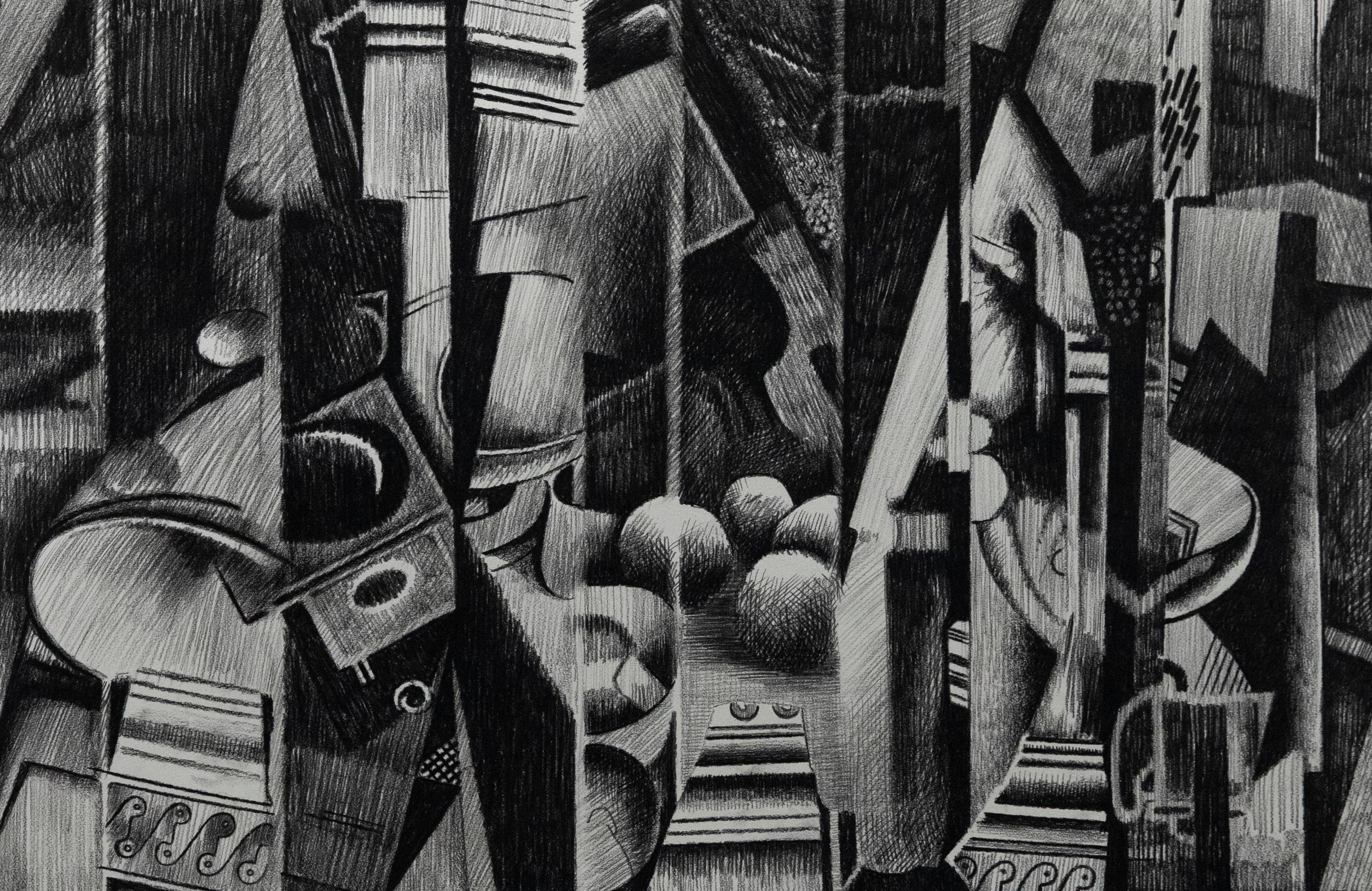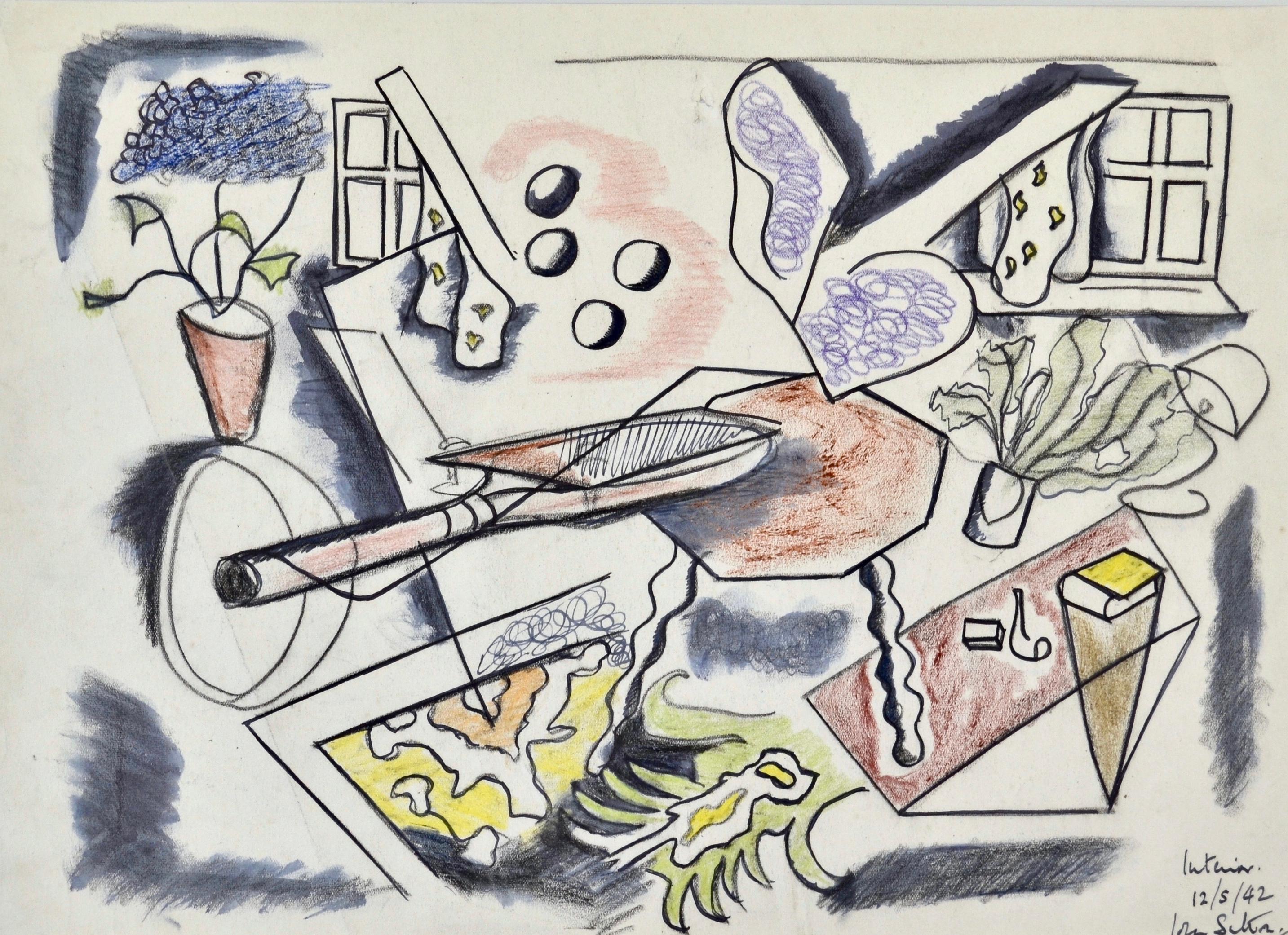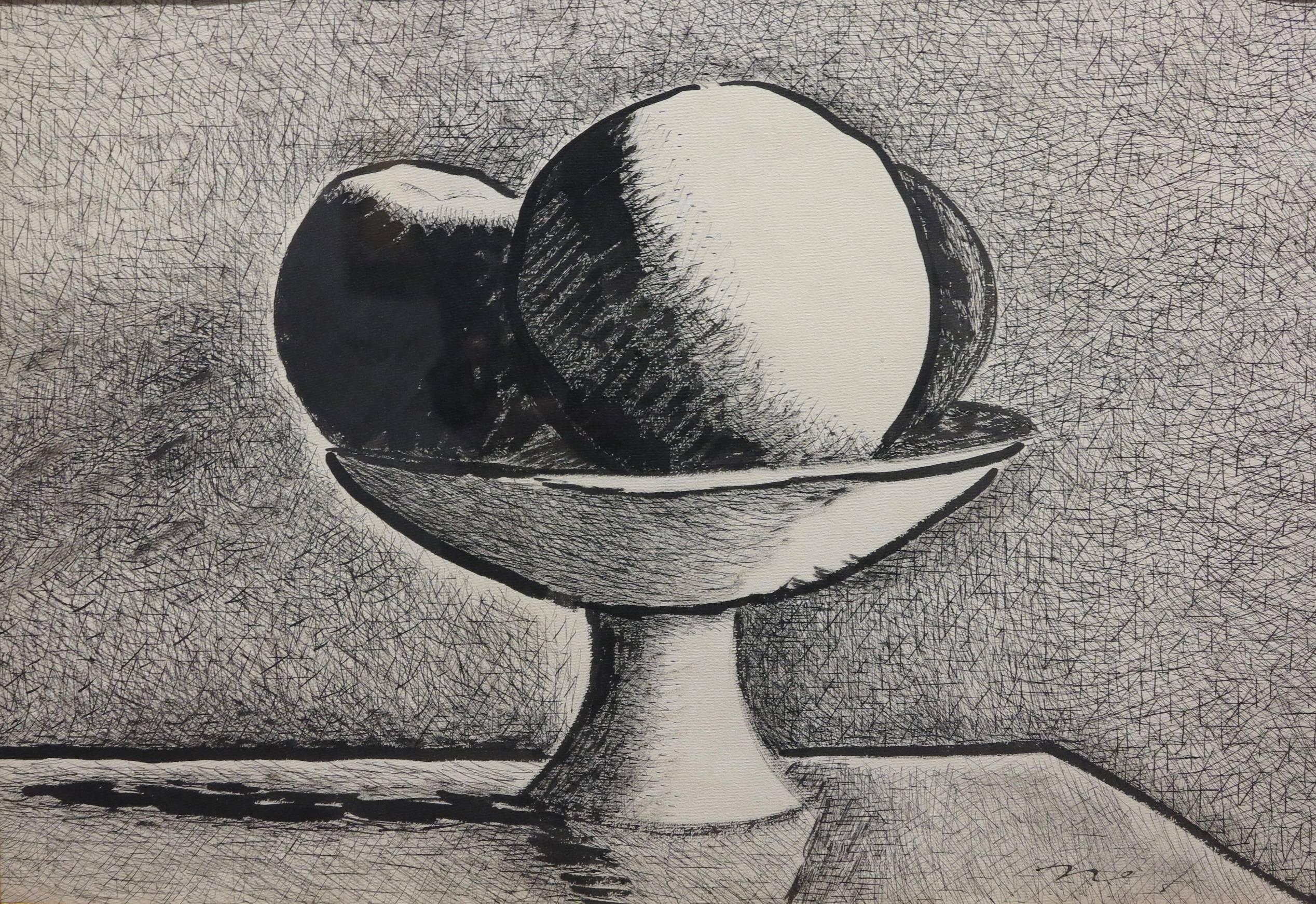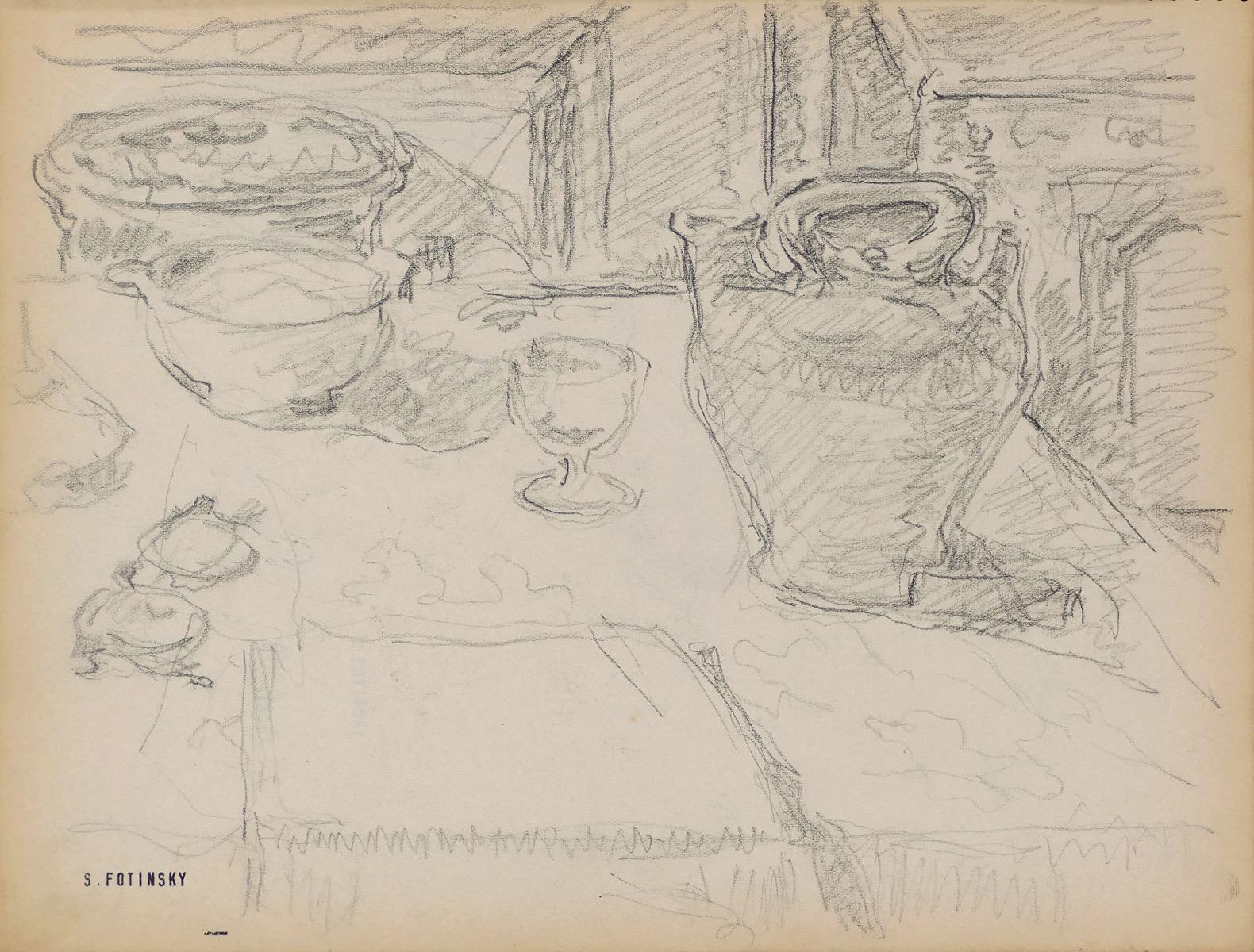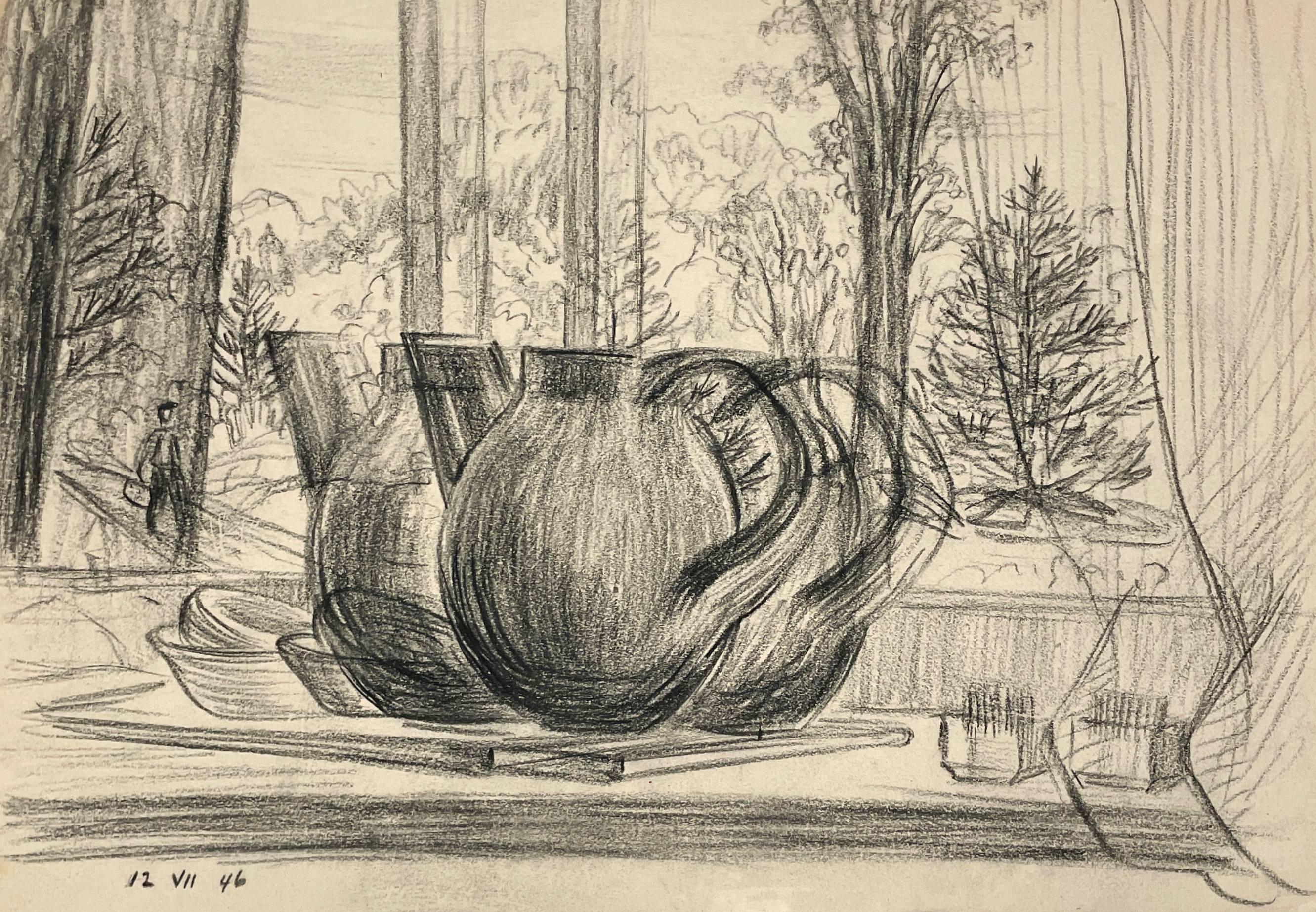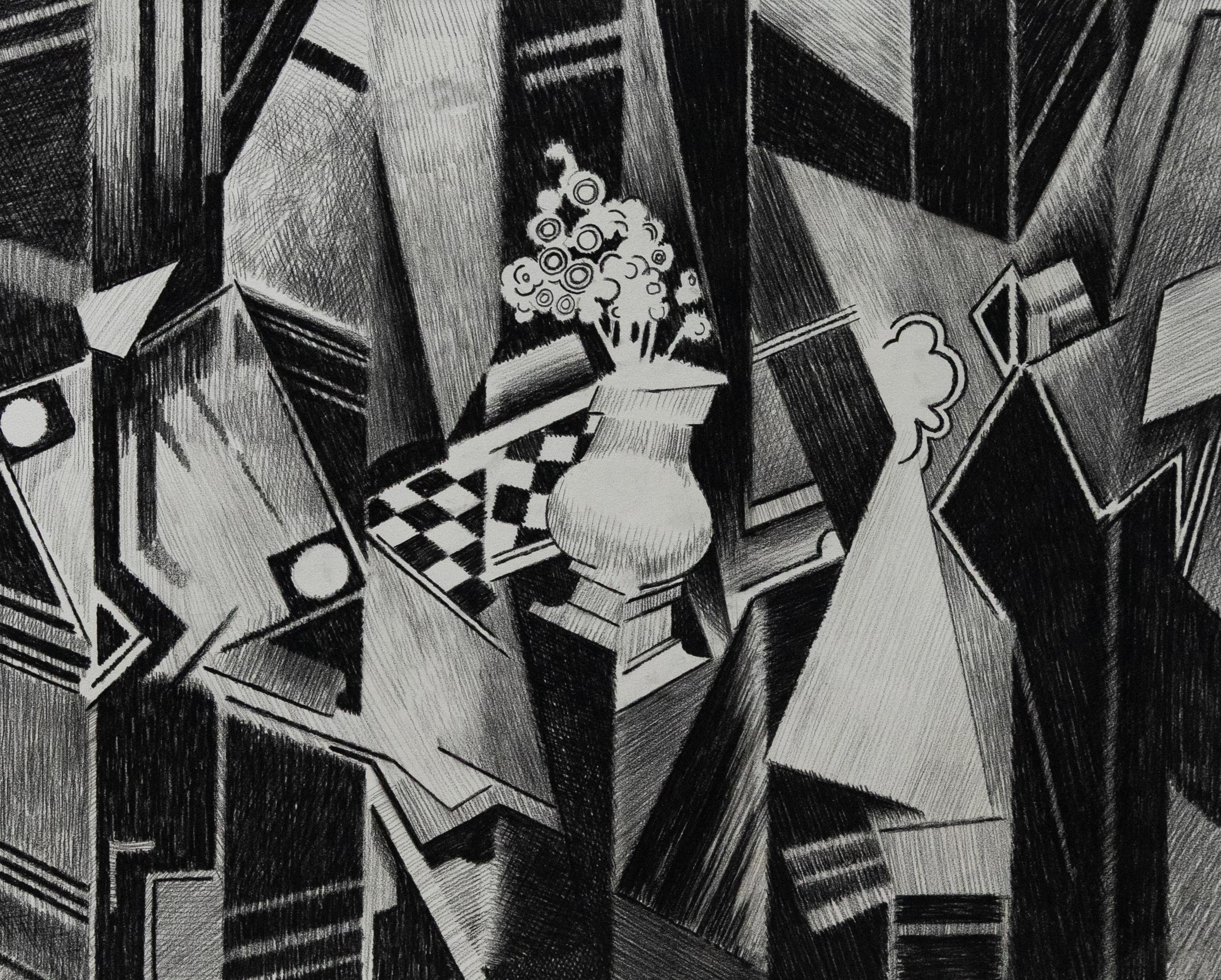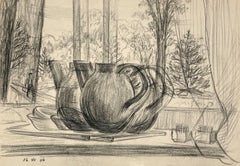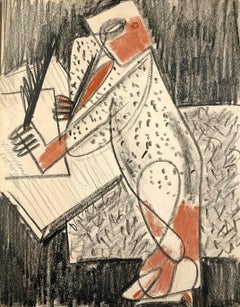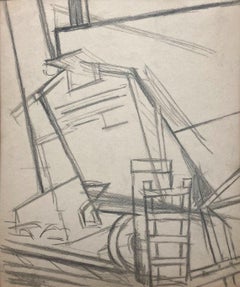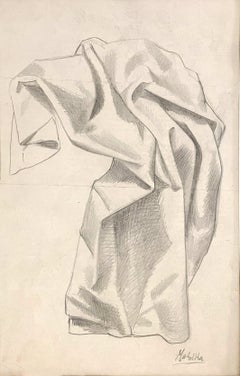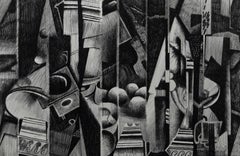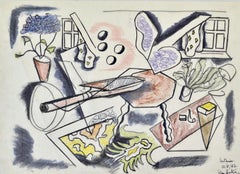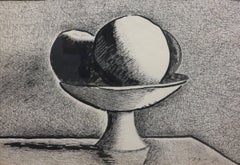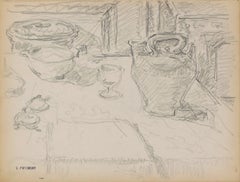Items Similar to Ca. 1945 Cubist Graphite on Paper Still Life Drawing by Artist Stanley Bielecky
Want more images or videos?
Request additional images or videos from the seller
1 of 8
Stanley BieleckyCa. 1945 Cubist Graphite on Paper Still Life Drawing by Artist Stanley Bieleckyca. 1945
ca. 1945
$485
$65025% Off
£366.31
£490.9325% Off
€423.34
€567.3725% Off
CA$680.29
CA$911.7225% Off
A$756.54
A$1,013.9325% Off
CHF 396.02
CHF 530.7425% Off
MX$9,228.93
MX$12,368.6625% Off
NOK 4,976.09
NOK 6,668.9825% Off
SEK 4,680.65
SEK 6,273.0425% Off
DKK 3,160
DKK 4,235.0525% Off
About the Item
A ca. 1945, Cubist black & white graphite drawing of fruit by artist Illinois and Michigan artist Stanley Bielecky. Image size: 4" x 5". Archivally matted to: 13 1/4" x 16".
Stanley Bielecky was an Indiana artist who painted the American scene, from the factories and workers around East Chicago to the bucolic settings of Mackinac Island. Born in Germany, Bielecky moved at a young age with his family first to Pennsylvania and then to the east side of Chicago (Illinois). Although his parents could not afford formal art training, Bielecky’s early works won competitions and scholarships and he started to attend weekend classes at the Art Institute of Chicago. Later, he attended the Minneapolis Institute of Art between 1930 and 1934, where he won the Edward M. Johnson scholarship. After graduation, Bielecky returned to the Art Institute of Chicago, where he attended additional classes until 1937. In 1938, he won a Tiffany Foundation Fellowship. In 1935, Bielecky was honored with a solo exhibition at the Hoosier Salon Gallery. Despite his artistic success, like many artists, Bielecky struggled financially during the Great Depression and often worked odd jobs in addition to taking on commercial art projects which helped keep him afloat. Bielecky also obtained a teaching position as an art instructor at the Calumet Center of Indiana University in East Chicago (Indiana). He later taught at Valparaiso University in 1941 and again after World War II. During the war, Bielecky worked as a camouflage artist in the European Theater. Bielecky continued to teach painting at Valparaiso University through 1957, while maintaining a private studio in East Chicago (Indiana) until 1970 when ill health forced his retirement. Beginning in the late 1930s, Bielecky’s works were accepted into juried exhibitions across the country, including at the Detroit Art Institute, the San Francisco Museum of Art, the Pennsylvania Academy of Fine Arts, the Art Institute of Chicago, the Albright-Knox Gallery and the Toledo Museum of Art. He won several prizes along the way, including the Marjorie Beth Maxon Prize at the Detroit Institute of Art. Cincinnati Art Galleries honored Bielecky with a solo retrospective in 1988, where Faces was exhibited.
Souce: CWamericanmoderism
- Creator:Stanley Bielecky (1903 - 1985, American, German)
- Creation Year:ca. 1945
- Dimensions:Height: 13.25 in (33.66 cm)Width: 16 in (40.64 cm)
- More Editions & Sizes:Matted to: 13 1/4" x 16"Price: $650
- Medium:
- Movement & Style:
- Period:
- Condition:See Photos.
- Gallery Location:Chicago, IL
- Reference Number:Seller: #33531stDibs: LU2591213191062
About the Seller
5.0
Recognized Seller
These prestigious sellers are industry leaders and represent the highest echelon for item quality and design.
Established in 2000
1stDibs seller since 2023
81 sales on 1stDibs
Typical response time: 1 hour
- ShippingRetrieving quote...Shipping from: Chicago, IL
- Return Policy
Authenticity Guarantee
In the unlikely event there’s an issue with an item’s authenticity, contact us within 1 year for a full refund. DetailsMoney-Back Guarantee
If your item is not as described, is damaged in transit, or does not arrive, contact us within 7 days for a full refund. Details24-Hour Cancellation
You have a 24-hour grace period in which to reconsider your purchase, with no questions asked.Vetted Professional Sellers
Our world-class sellers must adhere to strict standards for service and quality, maintaining the integrity of our listings.Price-Match Guarantee
If you find that a seller listed the same item for a lower price elsewhere, we’ll match it.Trusted Global Delivery
Our best-in-class carrier network provides specialized shipping options worldwide, including custom delivery.More From This Seller
View AllA Compelling, Surrealist 1946 Mid-Century Modern Still Life by Harold Haydon
By Harold Haydon
Located in Chicago, IL
A Compelling, Surrealist 1946 Mid-Century Modern Still Life Drawing by Notable Chicago Artist, Harold Haydon (Am. 1909-1994). A visually striking, finely executed charcoal drawing o...
Category
Mid-20th Century Surrealist Interior Drawings and Watercolors
Materials
Paper, Charcoal
A Dynamic 1945 Mid-Century Modern Cubist Studio Scene, Artist Sketch Class
By Harold Haydon
Located in Chicago, IL
A Dynamic, 1945 Mid-Century Modern Cubist Studio Scene, Artist's Sketch Class by Noted Chicago Painter, Harold Haydon (Am. 1909-1994). Artwork size: 11 x 8 1/2 inches, unframed, mo...
Category
Mid-20th Century Cubist Abstract Drawings and Watercolors
Materials
Paper, Charcoal, Pastel
A Graphite on Paper Mural Study of a Rail Yard by Rudolph Weisenborn, ca. 1940
By Rudolph Weisenborn
Located in Chicago, IL
A graphite on paper, untitled mural study, Cubist scene of a rail yard by important Chicago Modernist artist Rudolph Weisenborn, ca. 1940. Artwork size: 11 3/4" x 9 3/4". Archivally matted to 16" x 18". Provenance: Estate of the artist.
Rudolph Weisenborn was born in Strassburg, Germany in 1881, but was orphaned at the age of nine. He was taken-in by Mid-Western farmer Thomas Westaby and spent his early years in Wisconsin, Iowa and North Dakota. Weisenborn first attended the University of North Dakota in 1898, then the Students School of Art in Denver. Various accounts have him working out west as a gold miner and cowboy.
Around 1912, he settled in Chicago and worked as a window designer for Marshall Field’s. Weisenborn is best known as the founder of the Chicago No-Jury Society of Artists. The group was founded because many artists could not get their work accepted into the mainstream Art Institute shows. Weisenborn is quoted as saying that he harbored feelings of disdain for any jury and that his own paintings were frequently rejected by conservative jurors. He was also involved and helped found other radical artist’s groups such as the Salon des Refuses, Cor Ardens and Neo-Arlimusic. In 1936, he helped found the New York-based American Abstract Artist’s Group. He created the only abstract mural for the 1933 Century of Progress Exhibition in Chicago and also worked for the Federal Arts Project in the Easel Division. His WPA murals can be found in Crane Technical High School and Nettlehorst Elementary School in Chicago, IL. In 1945, Chicago businessman Herman Spertus...
Category
1940s Cubist Abstract Drawings and Watercolors
Materials
Paper, Graphite
A ca. 1938 Graphite on Paper Study of Classical Drapery by Modernist Jan Matulka
By Jan Matulka
Located in Chicago, IL
A ca. 1938 graphite on paper, study of a classical drapery by notable Modernist artist Jan Matulka. The image is drawn on the back of a typewritten, folded sheet of stationery, from...
Category
1930s American Modern Still-life Drawings and Watercolors
Materials
Paper, Graphite
1930s Surrealist Still Life with Profile and Hanger by Artist Jan Matulka
By Jan Matulka
Located in Chicago, IL
A 1930 graphite on pencil drawing of Surrealist still life of an egg beater by notable artist Jan Matulka. Image size: 8 1/2" x 11". Archivally matted to...
Category
1930s Modern Still-life Drawings and Watercolors
Materials
Paper, Graphite
1951 Ink on Paper Still Life in an Interior by Artist Harold Haydon
By Harold Haydon
Located in Chicago, IL
A 1951 detailed ink on paper drawing of a still-life in an interior by artist Harold Haydon. Artwork size:
12" x 9". Archivally matted to 16" x 20".
Harold Emerson Haydon was bo...
Category
1950s American Modern Still-life Drawings and Watercolors
Materials
Paper, Ink
You May Also Like
Trevor Frankland (1931-2011) - 20th Century Graphite Drawing, Cubist Still Life
Located in Corsham, GB
Signed to the lower right. On paper.
Category
20th Century Still-life Drawings and Watercolors
Materials
Graphite
Interior - 1940s Cubist chalk drawing of an interior still life by John Sutton
By John Sutton
Located in London, GB
JOHN SUTTON
(20th Century)
Interior
Signed, inscribed with title and dated: 12/5/42
Watercolour and chalks, unframed, in mount only
25 by 34.5 cm., 10 by 13 ½ in.
(mount size 40 ...
Category
1940s Cubist Interior Drawings and Watercolors
Materials
Crayon
Still Life (New Hope Mid-century Modernist drawing)
By Lloyd Raymond Ney
Located in Wilton Manors, FL
Beautiful still life drawing by American artist, Lloyd Raymond Ney (1893-1964). Ink on paper, 14.5 x 21 inches; 25.5 x 31.5 inches framed. Excellent condition with no damage or restoration. Signed lower right.
Birth place: Friedenburg, PA.
Addresses: New Hope, PA, 1925-64
Profession: Painter, lecturer, teacher
Studied: PAFA with H. McCarter, 1914 -18 (Cresson Scholarship; traveled in Europe 1918-21; Paris in 1924)
Exhibited: AIC, 1937; Guggenheim Museum, 1941-56; PAFA Ann., 1941, 1951; numerous group shows in Europe.
Work: Guggenheim Museum, NYC. WPA commission, 1941, mural for New London, Ohio Post Office (Citizens of New London petitioned WPA administrator Edward Bruce to allow Ney to paint the mural)
Comments: Abstract painter. He spent many years in Paris, where he was friendly with Pascin, Foujita, Frieske, H.O. Tanner, W. Pach and Roger Fry...
Category
1950s Abstract Still-life Drawings and Watercolors
Materials
Ink
Still Life - Original Pencil Drawing by Serge Fontinsky - Mid-20th Century
By Serge Fontinsky
Located in Roma, IT
Sketch is an original sketch pencil drawing realized by Serge Fontinsky (1887-1971) in the half of the 20th Century.
Good conditions, minor cosmetic wear.
Hand-signed on the lower...
Category
Mid-20th Century Modern Figurative Drawings and Watercolors
Materials
Pencil
Trevor Frankland (1931-2011) - 20th Century Graphite Drawing, Vase of Flowers
Located in Corsham, GB
Well presented in a white card mount. Signed. On watercolour paper.
Category
20th Century Still-life Drawings and Watercolors
Materials
Graphite
Untitled - Still Life 2, Cubist Ink on Paper by Benjamin Benno
By Benjamin G. Benno
Located in Long Island City, NY
Untitled - Still Life 2
Benjamin Benno, American (1901–1980)
Date: 1936
Ink on paper, signed and dated
Size: 3.63 x 5.25 in. (9.21 x 13.34 cm)
Frame Size: 10.75 x 12.25 inches
Category
1930s Cubist Abstract Drawings and Watercolors
Materials
Ink
More Ways To Browse
San Francisco Drawing
Cincinnati Artist
Stanley Vintage
Vintage Face Drawing
Stanley Blacker
Cubist Drawings
Stanley American Modern
1930s Cubist Painting
Artist Marjorie
Cubist Face Painting
Cincinnati Ii
Hoosier Art
Bright Watercolor
Watercolor Paintings Of A Flower
Watercolor Garden
Antique Pencil Drawings
Vintage Chinese Painting
Watercolor Death
